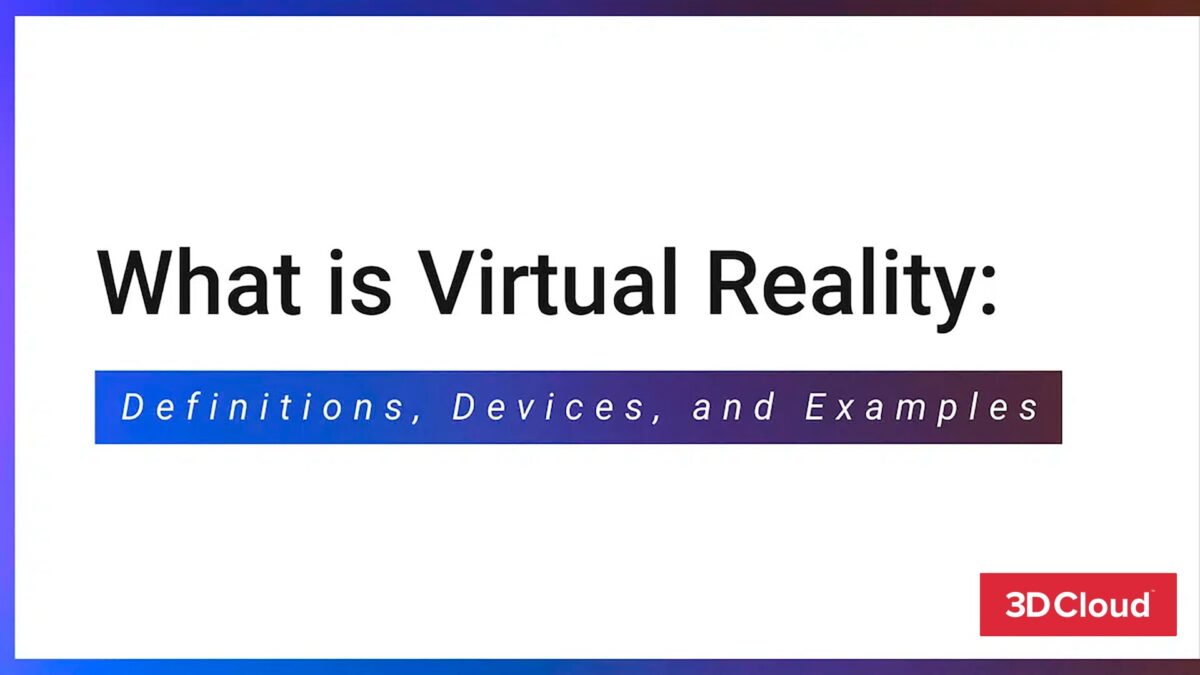
What is Virtual Reality
Virtual reality (VR) technology is a growing force beyond entertainment and an important tool in education, science, commerce, manufacturing, and more. Learn the basics and the latest from experts about how VR impacts your world.
In this article, you’ll find:
What Is Virtual Reality?
Virtual reality is the use of computer technology to create simulated environments. Virtual reality places the user inside a three-dimensional experience. Instead of viewing a screen in front of them, users are immersed in and interact with 3D worlds.
Simulation of human senses—all five of them—transforms a computer into a vehicle into new worlds. The only limitation to a superb VR experience is computing power and content availability.
Sam Trudgian , a VR developer at Napster, says, “VR and AR are in a state of innovation now. Headsets are getting smaller, faster and wireless.
, a VR developer at Napster, says, “VR and AR are in a state of innovation now. Headsets are getting smaller, faster and wireless.
“We’ve only just begun the journey into mass-produced consumer headsets, used by businesses to present proposals and products to clients. AR is already popular in architecture and development, and not just with private developers. Local authorities and councils use this technology for town planning and sustainable development. AR doesn’t require a headset at this stage, so it’s extremely accessible, but I’d like to see AR and VR together in a headset in the future as this currently isn’t possible.”
The Three Types of Virtual Reality
All three types of VR, from non-immersive, semi-immersive, full immersive or a mixture of them, are also referred to as extended reality (XR). Three types of virtual reality experiences provide different levels of computer-generated simulation.
The three main VR categories are the following:
- Non-Immersive Virtual Reality: This category is often overlooked as VR simply because it’s so common. Non-immersive VR technology features a computer-generated virtual environment where the user simultaneously remains aware and controlled by their physical environment. Video games are a prime example of non-immersive VR.
- Semi-Immersive Virtual Reality: This type of VR provides an experience partially based in a virtual environment. This type of VR makes sense for educational and training purposes with graphical computing and large projector systems, such as flight simulators for pilot trainees.
- Fully Immersive Virtual Reality: Right now, there are no completely immersive VR technologies, but advances are so swift that they may be right around the corner. This type of VR generates the most realistic simulation experience, from sight to sound to sometimes even olfactory sensations. Car racing games are an example of immersive virtual reality that gives the user the sensation of speed and driving skills. Developed for gaming and other entertainment purposes, VR use in other sectors is increasing.
The virtual technology definition includes specific shared characteristics. Not only immersive, they are also computer-generated, believable as multidimensional experiences, and interactive.
What’s the Difference Between Virtual Reality and Augmented Reality?
Virtual reality (VR) is an all-enveloping artificial and fully immersive experience that obscures the natural world. Augmented reality (AR) enhances users’ real-world views with digital overlays that incorporate artificial objects.
VR creates synthetic environments through sensory stimuli. Users’ actions impact, at least partially, what occurs in the computer-generated environment. Digital environments reflect real places and exist apart from current physical reality.
In AR, the real world is viewed directly or via a device such as a camera to create a visual and adds to that vision with computer-generated inputs such as still graphics, audio or video. AR is different from VR because it adds to the real-world experience rather than creating a new experience from scratch.
How Does Virtual Reality Technology Work?
The VR process combines hardware and software to create immersive experiences that “fool” the eye and brain. Hardware supports sensory stimulation and simulation such as sounds, touch, smell or heat intensity, while software creates the rendered virtual environment.
Eye and Brain Function and the 3D VR Experience
Immersive experience creation mimics how the eye and brain form visuals. Human eyes are about three inches apart and therefore form two slightly different views. The brain fuses those views to create a sense of depth or stereoscopic display.
VR applications replicate that phenomenon with a pair of exact images from two different perspectives. Instead of a single image covering the entire screen, it shows two identical pictures made to offset the view for each eye. VR technology fools the viewer’s brain into perceiving a sense of depth and accept the illusion of a multi-dimensional image.
What Technology Does Virtual Reality Use?
VR technology commonly consists of headsets and accessories such as controllers and motion trackers. Driven by proprietary downloadable apps or web-based VR, the technology is accessible via a web browser.
What Hardware Does Virtual Reality Use?
Virtual reality hardware includes sensory accessories such as controllers, as well as headsets, hand trackers, treadmills and, for creators, 3D cameras.
VR Headsets
A VR headset is a head-mounted device, such as goggles. A VR headset is a visual screen or display. Headsets often include state-of-the-art sound, eye or head motion-tracking sensors or cameras.
There are three main types of headsets:
- PC-Based VR Headsets: PC headsets tend to be the highest-priced devices because they offer the most immersive experiences. These headsets are usually cable-tethered from the headset and powered by external hardware. The dedicated display, built-in motion sensors and an external camera tracker offer high-quality sound and image and head tracking for greater realism.
- Standalone VR Headsets: All-in-one or standalone VR headsets are wireless, integrated pieces of hardware, such as tablets or phones. Wireless VR headsets are not always standalone. Some systems transmit information wirelessly from consoles or PCs in proximity, and others use wired packs carried in a pocket or clipped to clothing.
- Mobile Headsets: These shell devices use lenses that cover a smartphone. The lenses separate the screen to create a stereoscopic image that transforms a smartphone into a VR device. Mobile headsets are relatively inexpensive. Wires are not needed because the phone does the processing. Phones don’t offer the best visual experiences and are underpowered by game console- or PC-based VR. They provide no positional tracking. The generated environment displays from a single point, and it is not possible to look around objects in a scene.
VR Accessories
VR accessories are hardware products that facilitate VR technology. New devices are always in development to improve the immersive experience. Today’s accessories include the 3D mouse, optical trackers, wired gloves, motion controllers, bodysuits, treadmills, and even smelling devices.
These are some of the accessories used today in VR:
- 3D Mouse: A 3D mouse is a control and pointing device designed for movement in virtual 3D spaces. 3D mice employ several methods to control 3D movement and 2D pointing, including accelerometers, multi-axis sensors, IR sensors and lights.
- Optical Trackers: Visual devices monitors the user’s position. The most common method for VR systems is to use one or multiple fixed video cameras to follow the tracked object or person.
- Wired Gloves: This type of device, worn on the hands, is also known as cyber gloves or data gloves. Various sensor technologies capture physical movement data. Like an inertial or magnetic tracking device, a motion tracker attaches to capture the glove’s rotation and global position data. The glove software interprets movement. High-end versions provide haptic feedback or tactile stimulation, allowing a wired glove to be an output device.
- Motion Controllers: These accessories allow users to act in mixed reality. Controllers allow for fine-grained interaction with digital objects because they have a precise position in space.
- Omnidirectional Treadmills (ODTs): This accessory machine gives users the ability to move in any direction physically. ODTs allow users to move freely for a fully immersive experience in VR environments.
- Smelling Devices: Smell devices are one of the newer accessories in the VR world. Vaqso, a Tokyo-based company, offers a headset attachment that emits odors to convey the size and shape of a candy bar. The fan-equipped device holds several different smells that can change intensity based on the screen action.
What Software Does Virtual Reality Use?
Developers use various software to build VR. They include VR software development kits, visualization software, content management, game engines, social platforms, and training simulators.
- VR Content Management Systems Software: Companies use this workplace tool to collect, store and analyze VR content in a centralized location.
- VR Game Engine Software: Developers use the tools to create a VR video game experience.
- VR Software Development Kit (SDK): SDKs offer a base to design, build and test VR experiences.
- VR Social Platforms Software: Users collaborate from remote locations in VR with these tools.
- VR Training Simulator Software: This software works for almost any industry for employee training in immersive environments.
- VR Visualization Software: Users experience aggregated data in a virtual environment. to fully understand what data means.
Non-Headset VR
Napster’s Trudgian points out another software technology that may someday disrupt headsets as a standard in VR: “Non-headset VR is coming, as demonstrated by the likes of Spatial, VRChat and RecRoom.
“These apps allow users or players without headsets to connect to the same environment and interact with one another. Adding support for non-headset users serves virtual worlds well by adding a user base on universally accessible devices and platforms. In theory, if a virtual world is not reliant on headset-only users, it can expand in size tremendously; the amount of people who have access to a web browser or smartphone is far greater than that of any headset.”
Importance of Audio in Virtual Reality
VR strives to emulate reality, so audio is vital role to creating credible experiences. Audio and visuals work together to add presence and space to the environment. Audio cues are also crucial for guiding users through their digital experience.
Convincing VR applications require more than graphics alone. Hearing and vision are also central to a person’s perception of space. People react more rapidly to audio cues than to visual indicators. To produce truly immersive virtual reality experiences, precise environmental noise and sounds as well as accurate spatial characteristics are required.
Binaural or Spatial Audio in Virtual Reality Experience
People hear in three dimensions. They can discern the direction sound comes from and the rough distance from the sound source. Simulation of aural sense delivers a more authentic multi-dimensional experience and is known as biaural or spatial audio.
Biaural or spatial audio emulates how human hearing functions. People have ears on both sides of the head and our brains adjust the sound accordingly. Sounds emanating from the right of the head reach the user’s ear with a time delay, and vice versa. We, therefore, perceive sound as if positioned at a specific point in three-dimensional space.
Binaural and spatial audio lend a powerful sense of presence to any virtual world. To experience the binaural audio elements that comprise a VR experience, put on your best headphones and play around with this audio infographic published by The Verge.
VR Technology Coming Soon
Anat Baron, a Futurist , notes, “We are moving to a post-mobile world, meaning fewer consoles and handheld devices and more wearables. In five to ten years, today’s headsets will look like first-generation cell phones or boxy CRT TVs.
, notes, “We are moving to a post-mobile world, meaning fewer consoles and handheld devices and more wearables. In five to ten years, today’s headsets will look like first-generation cell phones or boxy CRT TVs.
“This change will be driven by the significant opportunity ahead of a VR creator economy. New tools created for developers and anyone interested in creating VR content are necessary. Remember when YouTube started? Most people weren’t making and sharing videos, and now anyone can quickly become a video creator.”
“Today, most people don’t have a VR headset. Once the hardware is simplified and usage is more widespread, we’ll see the same phenomenon. Eventually, wearables like smart glasses of some type will replace smartphones. These wearables will allow even more uses for both VR and AR because users won’t need specialized hardware but will take advantage of the same device they use to communicate, search and interact with the world around them.”
“VR will provide creators and storytellers the unique ability to put users in other people’s shoes. This empathetic process has business implications for corporate training, especially in support of diversity, equity and inclusion.”
How Virtual Reality Applications Are Used Today
VR technology is associated with gaming, but it is used to support sales, facilitate learning, simulate travel, communicate, and more. Due to the pandemic, remote work, social interaction and virtual travel have increased VR use.
Virtual Reality Use Case Examples
VR has impacted businesses ranging from medicine to tourism and is a cornerstone of many corporate digital transformation strategies. For example, according to a November 2020 Statista report estimates for business investments in the U.S. industrial maintenance and training are forecast to hit $4.1 billion in 2024.
Futurist Baron says: “There will be significant opportunities for businesses to use VR both within their companies and with potential and existing customers.”
Baron offers her insights into these top use cases:
- Training: One of the most obvious is the use of VR in employee training. While this currently requires the use of a headset, it can also be done onsite or at home. The ability to put an employee in other people’s shoes (whether those of a co-worker or customer) delivers a unique experience that isn’t feasible otherwise. As the technology improves, this will become a valuable tool in all corporate training, including situations that require complex decision-making. VR makes sense in education. Imagine an immersive experience in history or science, for example. As technology progresses and our attention spans decrease, we will continue to expect well-rounded experiences when learning anything new.
- Travel: Hotels can take you inside their property, so you know what to expect. VR can be beneficial for high-end travel (e.g., honeymoons or luxury resorts). For the user, they’d see (and feel) the location from their perspective instead of watching an online video or looking at 2D photos.
- Real Estate: Developers can move beyond 3D models to simulate life inside their new development. VR would work both for homes and commercial spaces. Also, co-working spaces can use VR to put the prospective tenant inside the space before you join.
- Healthcare: There are many uses for healthcare practitioners, researchers and patients. Imagine using VR to help patients with disorders such as anxiety or anorexia. It would be invaluable in medical school to help students learn how to deal with situations that may arise when they become doctors (empathy training, for example). VR is already in use for surgical training.
- Retail: Retailers can help potential consumers put themselves in situations where they can “try on” clothes or objects and get a sense of how they interact with an environment. For example, a bride-to-be could try a wedding dress and place it in an actual wedding environment. VR is different from AR, where you stay in your current reality.
- Military: VR is already a valuable tool in simulations for combat, confrontations and the like. It can replace expensive and sometimes dangerous real-life exercises. The ability to change scenarios makes it attractive for all branches of the military and the defense industry.
- Entertainment: The ability to provide immersive experiences will transform entertainment. Gaming and Hollywood will increasingly provide users and viewers with the ability to go from passive to active. Consumers will interact with stories in a highly personalized way (should they wish to). The ability to choose your own POV in a game or movie will continue to provide new forms of engagement.
Other use cases include:
- Architecture: VR can render different levels of detail that are important in early-stage design. Architects can create an immersive experience to visualize massing and spatial relationships. Other uses can show how light will affect the proposed space, based on window placement.
- Art: VR as a tool for fine art is a staple for artists who aim to push limits. Multimedia artists all over the world are already deeply involved in immersive experiential art forms. Laurie Anderson, a pioneer since the 1970s, was awarded the 74th Venice International Film Festival for her work, The Chalkroom.
- Aviation: Realistic cockpits with VR technology are used to train commercial pilots in training programs incorporating live instruction with virtual flight.
- Aerospace: Lockheed Martin builds its F-35 plane with virtual reality technology. In addition to design, engineers now use VR glasses to inspect planes. VR enables engineers to work with up to 96 percent accuracy at a 30 percent faster rate.
- Conference Rooms: Users equip themselves with a headset that simulates a meeting room, complete with colleagues and furniture. Motion tracking, combined with digital avatars, allows users to control their digital selves and employ gestures. Even those without headsets use webcam video feeds superimposed on the virtual conference room.
- Data Visualization: Engineering and scientific data visualization have profited for years from VR. New display technology has aroused interest in everything from weather models to molecular visualization.
- Dining: Project Nourished replicates eating by manipulating taste, smell, vision, sound, and touch. People experience the virtual as a gourmet meal. The process uses a VR headset, an aroma diffuser, a system that emulates chewing sounds, a rotating utensil and tasteless, 3D-printed food. The project aims to maximize the practical and therapeutic qualities of beverages, medicine and food while limiting natural resource use.
- Education: The use of traditional instruction mediums and textbooks is often ineffective for students with special needs. With the introduction of VR, students have become more responsive and engaged. At Charlton Park Academy in London, teachers use immersive technology to address their students’ unique needs better.
- Fashion: You can find Dior’s VR store on its French website. The brand offers shoppers a 3D, 360-degree e-commerce experience. Users virtually browse the store’s offerings, zoom in on preferred items and purchase them online.
- Gaming: Say “virtual reality,” and gaming is the application people think of first. According to the Entertainment Software Association figures reported in March 2020, 73 percent of the 169 million gamers in the U.S. reported owning a gamin console, while 29 percent said they had a VR capable system.
- Manufacturing: Designers and engineers easily experiment with the build and look of vehicles before commissioning expensive prototypes with VR. Brands such as Jaguar and BMW use the technology for early design and engineering reviews. Virtual reality saves the car industry millions by reducing the number of prototypes built per vehicle line.
- Journalism: Immersive journalism allows the first-person experience of events or situations described in documentary films and news reports. The Weather Channel uses mixed reality to help communicate everything from wildfires to tornados to flooding.
- Law Enforcement: With the advent of VR goggles, virtual reality training has been a boon for law enforcement training. Incident training is realistic and helps prepare officers for everyday situations.
- Marketing and Advertising: Virtual reality for marketing allows organizations to bridge the gap between experience and action. VR changes the dynamic between consumers and brands since people seek VR experiences, such as those of Toms Shoes and The North Face.
- Museums: Through a mobile phone, projector, headset or web browser, visitors experience locations that would have been unreachable in the recent past. At the National Museum of Natural History in Paris, a permanent VR installation allows visitors to explore different animal species and their links. The exhibit simulates real experiences of interacting or observing animals in their natural habitats.
- Religion: There’s even an app to experience God. Believe VR and The Virtual Reality Church make it possible for people to worship in depth wherever they are. VR Church became extremely popular during pandemic shutdowns.
- Social Media: VR allows people to make connections in a more meaningful way. VRChat gives the power of creation to its community with a wide selection of social VR experiences. Users can hang out, play and chat with spatialized 3D audio, multiplayer VR games, virtual space stations, and expressive lip-synced avatars.
- Sports: VR is a training aid in many sports such as cycling, skiing, golf and gymnastics. At least three college programs—Auburn University, Vanderbilt University and the University of Arkansas—and multiple NFL teams use virtual reality systems.
Major Players in Virtual Reality and Latest Entries: Oculus, HTC, Sony and Valve
VR is always improving due to technology refinements, and the latest “category killers” change rapidly. Top-of-the-pack players include ongoing favorites from Oculus, HTC, Sony and Valve.
Top VR Headsets for 2021
| Name | Description | Price |
| Oculus Quest 2 | Standalone VR | $299 |
| Oculus Rift S | Tethered VR | $559 |
| HP Reverb G2 | Highest-resolution RC VR headset | $648 |
| Valve Index | High-powered, tethered VR | $999 |
| Sony PlayStation VR | For PS4 gamers | $419 |
| HTC Vive Cosmos | Whole-room VR | $699 |
Top Mobile VR Headsets for 2021
| Name | Type | Price |
| Oculus Quest 2 | A standalone device with advanced VR gaming and experiences | $299 |
| Samsung Gear VR | Enjoy more than 600 games and numerous 360-degree videos | $149 |
| Mattel View-Master Deluxe | A Google Cardboard-compatible headset that features a headphone connection for better audio. | $23 |
| Merge VR | Compatible with smartphones, from 123mm to 158mm in size | $49 |
| Nintendo Labo VR Kit | Cardboard device that combines DIY with gaming. | $59 |
| Google Cardboard | An easy and affordable way to immerse yourself in mobile VR | $9 – $39 |
Benefits of Virtual Reality
VR benefits many industries with its user engagement. VR is an excellent vehicle for training, conferencing, convenience, and communication.
Here are some of the benefits of VR:
- Practical Training: VR is a safe way to simulate dangerous situations for training purposes. Firefighters, pilots, astronauts and police can learn in a controlled environment before going into the field. Immersive experience narrows timeframes so trainees can more quickly become professionals.
- Engagement and Connection: VR is an engaging and entertaining experience for its users.
- Convenient Conferences: Virtual meetings save time and money, yet help maintain a sense of collegiality.
- “Tryout” Capability: Shoppers’s remorse may become a thing of the past with VR. You can use virtual reality to furnish your home, test-drive a car or try on wedding bands without leaving home.
Challenges of Virtual Reality
VR has some disadvantages despite its appealing sense of engagement, including technical issues, the potential for addiction, loss of human connection, and expense. It’s possible to mitigate some problems, but others are a fixed part of the VR experience.
Here are some VR disadvantages:
- Addiction: Some people become addicted to the VR experience in gaming and social media applications. People can assume different identifies, which can be addictive and cause social, psychological and biological issues.
- Health Problems: Extensive use of VR can create a loss of spatial awareness, nausea, dizziness, disorientation and nausea, also known as simulator sickness.
- Screen Door Effect: When you use a headset, the display is within inches of your eyes. That means you see pixels or the spaces between them, no matter how excellent the display resolution may be. This mesh-like effect can irritate some users. Newer headsets have improved but not eliminated the issue.
- Loss of Human Connections: When you rely on virtual connections rather than real-life social interactions, trouble may result. Over-reliance on VR can lead to disassociation or depression.
- Training Doesn’t Translate in the Real World: People trained in virtual reality may do well in the app or platform but can’t perform to the necessary standard in real-world situations.
- Expense: While prices are coming down, VR systems are not affordable for everyone.
The Future of VR in Business
Businesses differentiate themselves through technological hybrids to interest consumers in innovations, mainly through VR and AR applications. Nowhere is this more evident than in shopping and retail.
Virtual reality in retail is still in its infancy. According to a 2018 VR in Retail and Marketing report from ABI Research, VR technology in the retail and marketing sectors are on track to generate $1.8 billion by 2022. Virtual reality in retail helps vendors plan, design, research and engage customers. The technology offers companies a strong competitive advantage by keeping up to date with current patterns and trends, like 3D eCommerce.
3D Cloud Powers Retail with a VR Experience that Delights Buyers
If you have been looking to add VR to your in-store customer shopping experience but didn’t know where to start, we can help. 3D Cloud Virtual Reality shopping solutions offer white-glove service and an easy turnkey implementation informed by years of experience and hundreds of VR installations. Our unique Virtual Reality approach pairs the easy-to-use 3D Cloud-powered 3D Room Planner with a Virtual Reality experience that wows customers, supercharges sales, and slashes returns.
After creating a custom floor plan, shoppers can explore the space they built in VR mode with our 360° Panoramas that render in under two minutes. Featuring unmatched industry realism, 360° Panoramas build customer confidence and can be used for designer presentations, social media marketing, or a website gallery.
We invite you to view our VR Shopping Video.
Request a demo to learn more today.










